Updated 2015.
Fire blight of apple and pear
Erwinia amylovora
Apple, pear, several rosaceous ornamentals
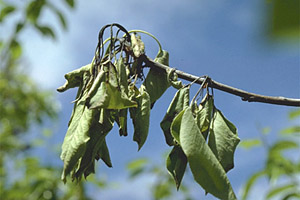
Pear shoot with fire blight. (Courtesy K. Johnson)
Symptoms and Signs
Symptoms of fire blight can be observed on all above ground tissues including blossoms, fruits, shoots, branches and limbs, and in the rootstock near the graft union on the lower trunk. Generally, symptoms of fire blight are easy to recognize and distinguishable from other diseases.
Blossom clusters and young shoots
Blossom symptoms are first observed 1-2 weeks after petal fall. The floral receptacle, ovary, and peduncles become water soaked and dull, grayish green in appearance. Later these tissues shrivel and turn brown to black. Similar symptoms often develop in the base of the blossom cluster and young fruitlets as the infection spreads internally (Figure 2). During periods of high humidity, small droplets of bacterial ooze form on water-soaked and discolored tissues (see example on fruit, Figure 7). Ooze droplets are initially creamy white, becoming amber-tinted as they age.
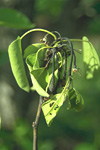
Figure 2 |
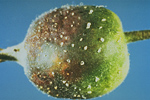
Figure 7 |
Shoot symptoms
Shoot symptoms are similar to those in blossoms but develop faster. Tips of shoots may wilt rapidly to form a "shepherd's crook" (Figures 1 and 3). Leaves on diseased shoots often show blackening along the midrib and veins before becoming fully necrotic. Numerous diseased shoots give a tree a burnt, blighted appearance, hence the disease name (Figure 4).
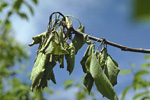
Figure 1 |
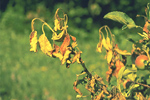
Figure 3 |
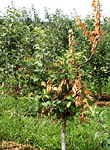
Figure 4 |
Advanced foliar symptoms
Infections initiated in blossoms and shoots can continue to expand both up and down larger branches and limbs. Bark on younger branches becomes darkened and water-soaked (Figure 5). At advanced stages, cracks will develop in the bark, and the surface will be sunken slightly (Figure 6). Amber-colored bacterial ooze mixed with plant sap may be present on bark. Wood under the bark will show streaked, brown to black discolorations.
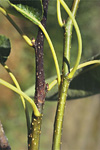
Figure 5 |
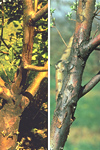
Figure 6 |
Pear and apple fruits
Indeterminate, water-soaked lesions form on surfaces of immature fruit and later turn brown to black. Droplets of bacterial ooze may form on lesions, usually in association with lenticels (Figure 7). Severely diseased fruits blacken completely and shrivel.
Apple rootstocks
Rootstock infections usually develop near the graft union as a result of internal movement of the pathogen through the tree or from infections through water sprouts or burr knots. The bark of infected rootstocks may show water-soaking, a purplish to black discoloration, cracking, and signs of bacterial ooze. Red-brown to black streaking may be apparent in wood just under the bark (Figure 8). Symptoms of rootstock blight can be confused with Phytophthora collar rot. M.26 and M.9 rootstocks are highly susceptible to the pathogen.
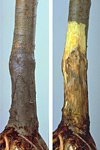
Figure 8 |
Pathogen Biology
Erwinia amylovora is a member of the family Enterobacteriacae. Cells of
E. amylovora are gram-negative, rod-shaped, measure 0.5-1.0 x 3.0 mm, and flagellated on all sides (peritrichous) (Figure 9). Physiologically,
E. amylovora is classified as a facultative anaerobe. It grows on most standard microbiological media and on several differential media. Optimum temperature for growth is 27°C (81°F), with cell division occurring at temperatures ranging from 5 to 31°C (41 to 88°F). Identification of
E. amylovora isolates is based on biochemical tests, inoculation of immature pear fruits and apple seedlings, sequencing of the 16S ribosomal RNA gene and through use of species-specific PCR primers.
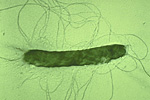
Figure 9 |
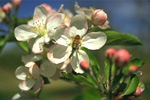
Figure 10 |
Epiphytic and endophytic biology
On flowers,
E. amylovora is an excellent colonizer of the surfaces of stigmas and, to a lesser extent, the surface of the nectary. This reproduction on floral surfaces is called epiphytic growth and occurs without the bacterium causing disease. Epiphytic growth of
E. amylovora on stigmas combined with movement of the pathogen from flower to flower by pollinating insects (Figure 10) are two important processes that regulate the incidence of blossom infection.
Erwinia amylovora also can survive on other healthy plant surfaces, such as leaves and branches, for limited periods (weeks), but colony establishment and epiphytic growth on these surfaces does not occur. Cells of
E. amylovora excrete large amounts of an extracelluar polysaccharide (a major component of bacterial ooze), which creates a matrix that protects the pathogen on plant surfaces. In propagation nurseries, cells of
E. amylovora surviving on woody surfaces can initiate disease when scions and rootstocks are wounded during grafting.
Erwinia amylovora also can reside as an endophyte within apparently healthy plant tissue, such as branches, limbs, and budwood. Migration of the pathogen through xylem is one mechanism by which floral infections of apple can lead to rootstock infections near the graft union.
Disease Cycle and Epidemiology
Disease Cycle
Overwintering
Erwinia amylovora overwinters in a small percentage of the annual cankers that were formed on branches diseased in the previous season. These overwintering sites are called “holdover cankers”. As temperatures warm in spring, the pathogen becomes active in the margins of holdover cankers. Free bacterial cells are released onto the bark surface, sometimes as visible ooze. Insects attracted to the ooze (e.g., flies) or rain disseminate the bacteria from the canker to flowers.
Floral epiphytic phase
Stigmas, which are borne on the end of the styles, are the principal site of epiphytic colonization and growth by
E. amylovora. During the floral epiphytic phase, the ultimate population size that the pathogen attains is influenced by temperature, which regulates the generation time of the pathogen, and by the number of blossoms in which the pathogen becomes established, which is facilitated by pollinating insects, honey bees in particular. Under ideal conditions, stigmas of each flower can support ~106 cells of the pathogen.
Primary infection in flowers
Blossom blight is initiated when cells of
E. amylovora are washed externally from the stigma to the hypanthium (floral cup). On the hypanthium,
E. amylovora gains entry to the plant through secretory cells (nectarthodes) located on the surface. In pear, the importance of blossom blight is expanded further by the tendency of this species to produce nuisance, secondary or “rattail” flowers during late spring and early summer, long after the period of primary bloom.
Secondary phases
This includes shoot, fruit, and rootstock blight. These phases are usually initiated by inoculum produced on tissues diseased as a result of blossom infection. Wounds are generally required by
E. amylovora to initiate shoot and fruit blight. Insects, such as plant bugs and psylla, create wounds on succulent shoots during feeding. Strong winds, rain, and hail can create numerous, large wounds in host tissues. Infection events induced by severe weather are sometimes called “trauma blight.” Rootstock blight of apple can result from shoot blight on water sprouts or from internal translocation of
E. amylovora from infections higher on the tree.
Canker expansion
Both primary and secondary infections can expand throughout the summer, with the ultimate severity of an infection being dependent on the host species, cultivar, environment, and age and nutritional status of the host tissues. Young, vigorous tissues and trees are more susceptible to fire blight than older, slower growing tissues or trees. Similarly, trees that have received an excess of nitrogen fertilizer, and therefore are growing rapidly, are more susceptible than trees growing under a balanced nutrient regime. Rates of canker expansion also can be enhanced by a high water status in a tree caused by excessive or frequent irrigation or poorly drained soils. Canker expansion slows in late summer as temperatures cool and growth rates of trees and shoots decline.
Epidemiological models
Blossom blight is sporadic from season to season owing to the requirement for warm temperatures to drive the development of large epiphytic populations. Several epidemiological models (e.g., COUGARBLIGHT, MARYBLYT) predict the likelihood of blossom blight epidemics based on observed climatic conditions (Figure 11). The models work by identifying the periods conducive for epiphytic growth of
E. amylovora on blossoms before infection occurs, and thus are used widely to aid decisions on the need for and timing of chemical applications. Blossom blight risk models accumulate degree units above a threshold temperature of 15.5 (60°F) or 18°C (64°F). Data on rain or blossom wetness during periods of warm weather are also used in the models to indicate more precisely the timing and likelihood of floral infection. Other temperature-based models predict the time to symptom expression after an infection event (i.e., the length of the incubation period) based on heat unit sums. These models are used to time orchard inspections and/or pruning activities.
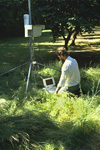
Figure 11 |
Disease Management
Effective management of fire blight is multi-faceted and largely preventative. The grower must utilize a combination of sanitation, cultural practices, and sprays of chemical or biological agents to keep the disease in check.
Cultivars
Selection of a resistant cultivar is the most effective method of controlling fire blight. In apple, for example, some cultivars exist that are moderately resistant to the disease (e.g., Red and Golden Delicious). For pears, cultivar choices are more limited because superior horticultural traits (e.g., taste, storage, and marketing qualities) have been difficult to combine with higher levels of disease resistance. In recent years, fire blight has become more common in apples because the spectrum of cultivars grown commercially has expanded and shifted toward those with greater susceptibility to the disease (e.g., Fuji, Gala, Pink Lady). With this shift has come the recognition that popular dwarfing rootstocks for apple, M.9 and M.26, are highly susceptible to
E. amylovora. Dwarfing rootstocks with resistance to fire blight are being developed and commercialized (e.g., the Geneva rootstock series from Cornell University). Many ornamental cultivars also show high levels of fire blight resistance.
Elimination of overwintering inoculum
Vigilant sanitation through the removal of expanding and overwintering cankers is essential for control of fire blight in susceptible cultivars. Removal of overwintering ("holdover") cankers is accomplished by inspecting and pruning trees during the winter.
Prevention of blossom blight
Prevention of blossom infection is important in fire blight management because infections initiated in flowers are destructive and because the pathogen cells originating from floral infections provide much of the inoculum for secondary phases of the disease, including the infection of shoots, fruits, and rootstocks. Management actions to suppress blossom blight target the floral epiphytic phase. Sprays of antibiotics, streptomycin, oxytetracycline or kasugamycin, have effectively suppressed blossom infection in commercial orchards (Figure 12).
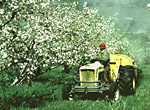
Figure 12 |
Copper compounds also are effective but applications are commonly limited to the pre-bloom period because copper ions in solution can be phytotoxic to the skin of young fruits.
E. amylovora has become resistant to streptomycin in some production areas, limiting the effectiveness of this chemical. Non-pathogenic, microbial epiphytes sprayed onto flowers can preemptively suppress fire blight by colonizing the niche (stigmatic surface) used by
E. amylovora to increase its epiphytic population size. The bacterium
Pseudomonas fluorescens strain A506, is registered and sold commercially for this purpose (BlightBan A506) as is the yeast,
Aureobasidium pullulans (Blossom Protect).
Mid-season suppression of established infections
In summer, established infections are controlled principally by pruning. Effective control through pruning requires that cuts are made 20-30 cm (8 to 12 inches) below the visible end of the expanding canker (Figure 13) and that between cuts the pruning tools are disinfested with a bleach or alcohol solution to prevent cut-to-cut transmission. Repeated trips through an orchard are necessary, as some as infections are invariably missed and others become visible at later times (Figure 14). Prunings harboring the pathogen are usually destroyed by burning (Figure 15).

Figure 13 |
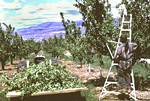
Figure 14 |
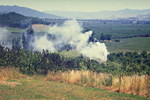
Figure 15 |
In severely affected orchards, cultural practices that slow the growth rate of the tree will also slow the rate of canker development. This includes withholding irrigation water, nitrogen fertilizer, and cultivation. Similarly, practices that reduce tree wounding and bacterial movement can reduce secondary infection. This includes controlling insects such as plant bugs and psylla, limiting use of limb spreaders in young orchards, and avoiding the use overhead sprinklers. Chemicals such as streptomycin or copper can suppress trauma blight if applied immediately after a hailstorm.
Significance
Erwinia amylovora is a native pathogen of wild, rosaceous hosts in eastern North America. These hosts include hawthorn, serviceberry, and mountain ash. Early European settlers introduced apple and pear to North America. The first report of fire blight as a disease of apple and pear occurred in 1780, in the Hudson Valley of New York. In California, the disease was first reported in 1887.
Early 19th and 20th century horticultural texts and bulletins recognized fire blight as a serious disease of pear, provided descriptions of symptoms, and outlined pruning practices for control (Figure 16). Nonetheless, in the eastern United States, fire blight proved to be destructively epidemic on pear, limiting the cultivation of this host. Even today, the threat of fire blight restricts commercial production of pear to semi-arid, desert areas west of the Rocky Mountains.
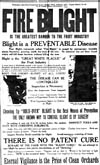
Figure 16 |
Erwinia amylovora has the distinction of being the first bacterium shown to be a pathogen of plants. Koch's postulates for
E. amylovora were fulfilled by J.C. Arthur in 1885, but the genesis of the concept that bacteria can be plant pathogens required the contributions of many scientists (notably T.J. Burrill) and growers over a period extending from 1846 to 1901.
E. amylovora is also one of the first plant pathogens to be associated with an insect vector. In the late 1890's, M.B. Waite linked blossom infection to the movement of the pathogen from flower-to-flower by pollinating insects.
During the 20th century, introductions of infested plant material served to establish
E. amylovora in Europe, the Middle East, and New Zealand. In 1995, fire blight was first observed in the Po River Valley of northern Italy, which is the largest pear production area in the world. Since 1995, the Italian government has destroyed 500,000 pear trees in an attempt to eradicate
E. amylovora. Recently, fire blight has spread eastward from the Middle East to the northern Himalayan foothills of central Asia (Kazakhstan, Kyrgyzstan), which is the center of origin for
Malus (apple) spp.
Selected Reading and References
Baker, K. F. 1971. Fire Blight of pome fruits: The genesis of the concept that bacteria can be pathogenic to plants. Hilgardia 40:603-633.
Beer, S.V. 1990. Fire Blight. Pages 61-63 in:
Compendium of Apple and Pear Diseases and Pests. Jones, A.L., and Aldwinckle, H.S. (eds.). APS Press, St. Paul, MN.
Johnson, K.B., and V.O. Stockwell. 1998. Management of fire blight: A case study in microbial ecology. Annu. Rev. Phytopathol. 36: 227-248.
McManus, P. and V. Stockwell. 2000. Antibiotics for plant disease control:
Silver bullets or rusty sabers?
Smith, T. J. 2015.
The development and use of Cougar Blight 1990 – 2010: A situation-specific fire blight risk assessment model for apple and pear.
Turechek, W. W., and Biggs, A. R. 2015. Maryblyt v. 7.1 for Windows: An improved fire blight forecasting program for apples and pears. Plant Health Progress doi:10.1094/PHP-RS-14-0046.
van der Zwet, T., and S.V. Beer. 1995. Fire Blight - Its Nature, Prevention, and Control: A Practical Guide to Integrated Disease Management. U.S. Dept. Agric., Agricultural Information Bull. No. 631.
van der Zwet, T., Orolaza-Halbrendt, N., and Zeller, W. 2012. Fire Blight: History, Biology, and Management, APS Press, St. Paul, MN. 460 pp.Vanneste, J.L. (ed.) 2000. Fire Blight: The disease and its causative agent,
Erwinia amylovora. CABI Publishing, Wallingford, UK.
